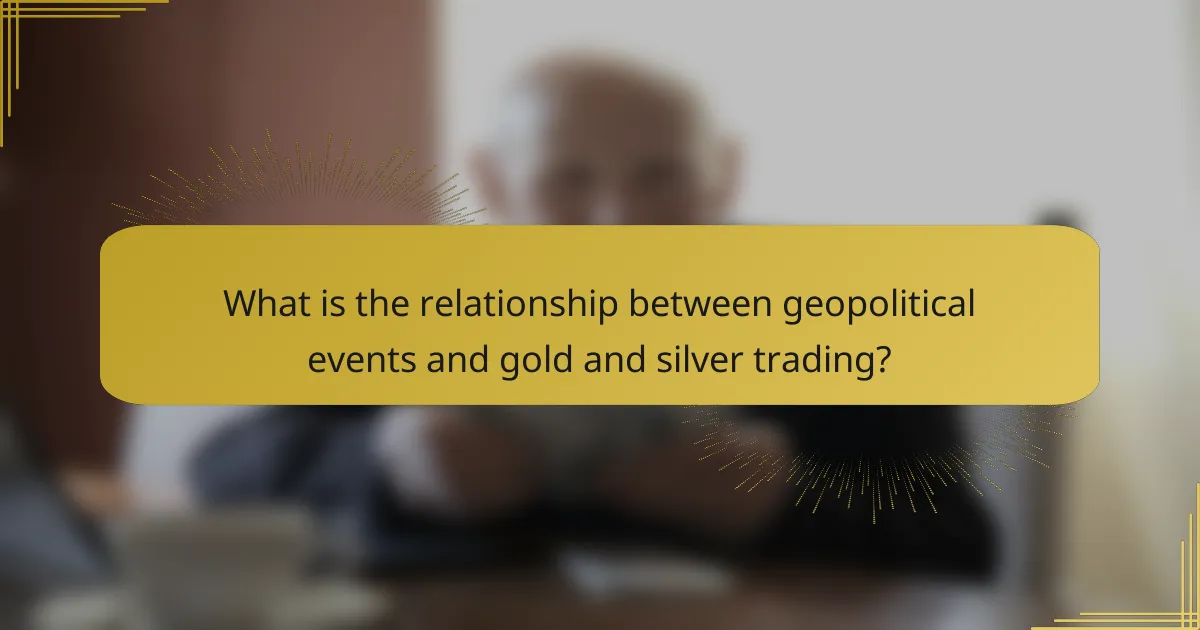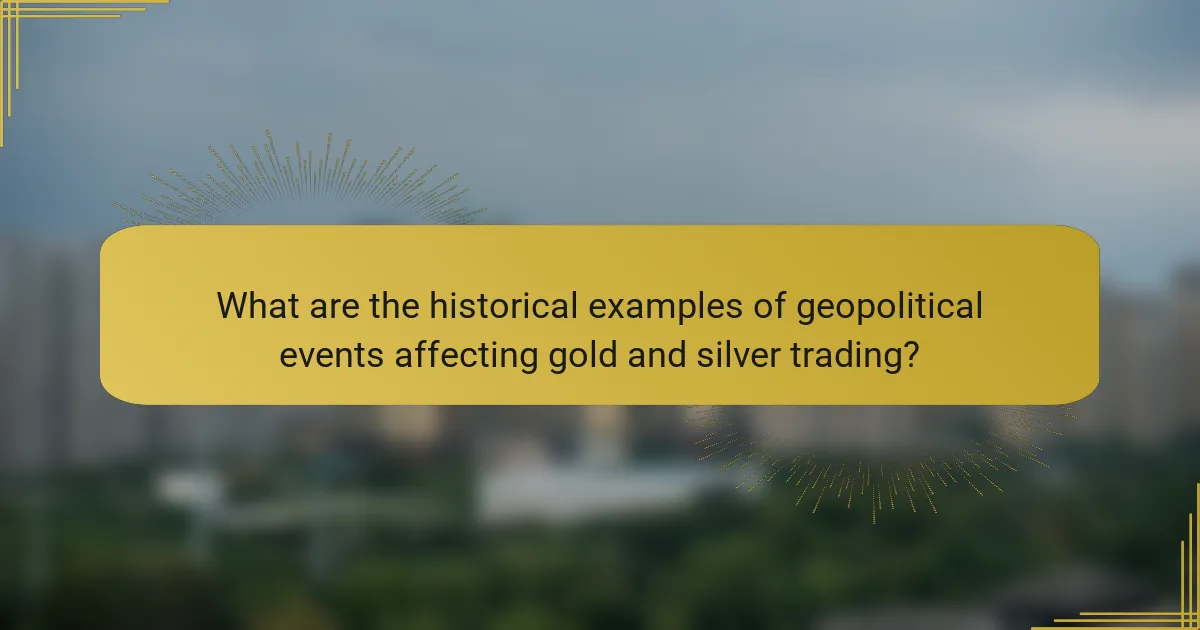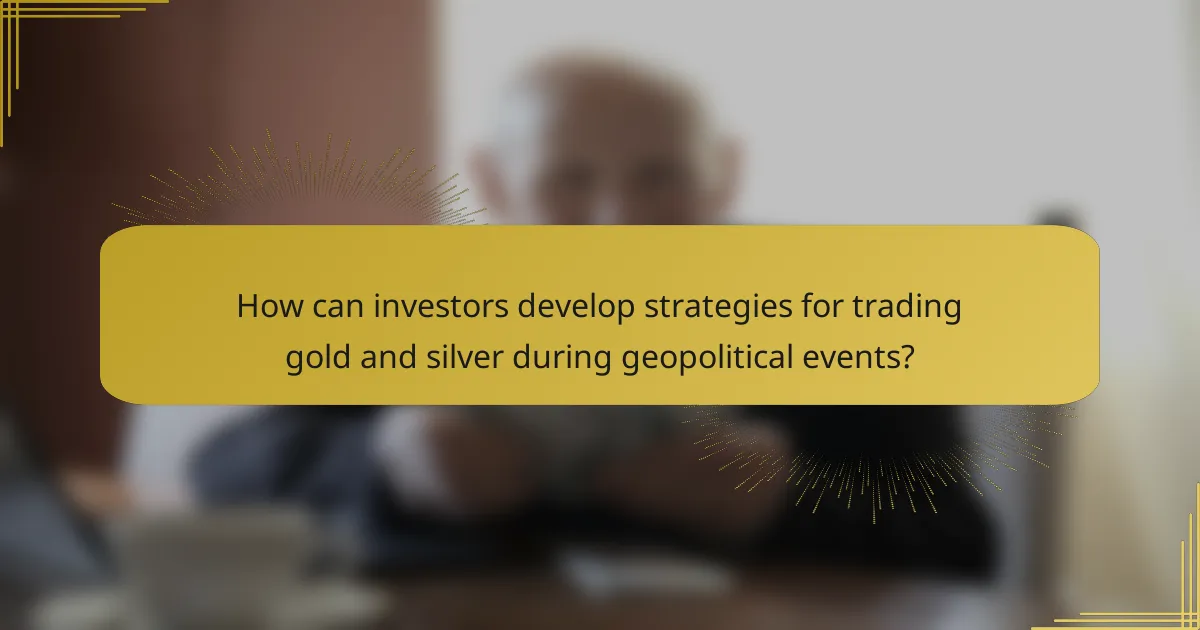Geopolitical events significantly impact gold and silver trading, as uncertainty in financial markets drives investors toward these precious metals as safe-haven assets. Historical examples, such as the 2008 financial crisis and conflicts in the Middle East, illustrate how geopolitical instability correlates with increased demand for gold and silver. The article explores the effects of major historical events, including World War I, the Great Depression, and the Cold War, on precious metal prices. It also outlines effective investment strategies for trading gold and silver during such events, emphasizing the importance of market analysis, diversification, and risk management techniques. Understanding these dynamics is crucial for investors looking to navigate the volatility caused by geopolitical factors.

What is the relationship between geopolitical events and gold and silver trading?
Geopolitical events significantly influence gold and silver trading. Such events create uncertainty in financial markets. Investors often seek safe-haven assets during these times. Gold and silver are traditionally viewed as safe investments. For example, during the 2008 financial crisis, gold prices surged as geopolitical tensions rose. Similarly, conflicts in the Middle East have historically led to spikes in precious metal prices. Data from the World Gold Council shows that gold demand increases during geopolitical instability. This trend reflects a broader investor behavior of flocking to tangible assets when facing uncertainty.
How do geopolitical events influence market trends for gold and silver?
Geopolitical events significantly influence market trends for gold and silver. These precious metals often act as safe-haven assets during times of uncertainty. For instance, conflicts or political instability typically drive investors to seek security in gold and silver. Historical data shows that during the 2008 financial crisis, gold prices surged as investors fled from riskier assets. Similarly, tensions in the Middle East have historically led to spikes in gold prices. In 2020, the COVID-19 pandemic caused increased demand for gold, pushing prices to record highs. The relationship between geopolitical events and market trends for gold and silver is well-documented and shows a clear pattern of increased demand during crises.
What historical examples illustrate this relationship?
The relationship between geopolitical events and gold and silver trading is illustrated by several historical examples. The 1971 Nixon Shock led to gold prices soaring as the U.S. abandoned the gold standard. Following this event, gold reached a record high of $850 per ounce in 1980, amidst rising inflation and geopolitical tensions. The Gulf War in 1990 also impacted precious metals; gold prices jumped as investors sought safe-haven assets during the conflict.
In 2008, the financial crisis triggered a surge in gold prices, reaching over $1,000 per ounce as uncertainty spread. The COVID-19 pandemic in 2020 further demonstrated this relationship, with gold hitting an all-time high of over $2,000 per ounce as investors reacted to economic instability. Each of these events showcases how geopolitical tensions and economic crises influence market reactions in gold and silver trading.
How do investors react to these geopolitical events?
Investors typically react to geopolitical events by adjusting their portfolios to mitigate risk. They often seek safe-haven assets like gold and silver during times of uncertainty. Historical data shows that gold prices tend to rise in response to geopolitical tensions. For instance, during the Gulf War in 1990, gold prices surged by over 30%. Similarly, in the wake of the 9/11 attacks, gold saw a significant increase in value. Investors also monitor market volatility and may shift to cash or defensive stocks. These reactions are driven by the desire to preserve capital and hedge against potential losses. Overall, geopolitical events create a climate of uncertainty that influences investor behavior significantly.
Why do gold and silver serve as safe-haven assets during geopolitical turmoil?
Gold and silver serve as safe-haven assets during geopolitical turmoil due to their intrinsic value and historical stability. Investors often turn to these metals when political instability threatens economic security. Gold and silver are tangible assets that retain value even when fiat currencies fluctuate. Historical events, such as the 2008 financial crisis, saw significant increases in gold prices as investors sought refuge. Moreover, these metals are not directly tied to any single economy, providing a hedge against currency devaluation. Their limited supply further enhances their appeal during uncertain times. Data from the World Gold Council shows that gold prices surged by over 25% during the COVID-19 pandemic’s onset, reflecting their role as a protective investment.
What characteristics of gold and silver make them appealing in uncertain times?
Gold and silver are appealing in uncertain times due to their intrinsic value and historical stability. Both metals serve as safe-haven assets during economic turmoil. Investors often turn to them to hedge against inflation and currency devaluation. Historical data shows that during crises, such as the 2008 financial meltdown, gold prices surged significantly. Silver also experienced increased demand as a tangible asset. Their liquidity allows for easy buying and selling in volatile markets. Additionally, gold and silver do not rely on government backing, making them attractive when trust in financial institutions wanes. This resilience is evidenced by their consistent performance during geopolitical tensions.
How do gold and silver prices typically respond to global crises?
Gold and silver prices typically rise during global crises. This increase occurs because investors seek safe-haven assets in times of uncertainty. Historical data shows that during the 2008 financial crisis, gold prices surged by 25% as market volatility increased. Similarly, in March 2020, amid the COVID-19 pandemic, gold reached an all-time high of over $2,000 per ounce. Silver also experienced significant price increases during these periods, reflecting heightened demand for precious metals. As a result, both metals are viewed as reliable stores of value during geopolitical tensions and economic downturns.

What are the historical examples of geopolitical events affecting gold and silver trading?
World War I significantly impacted gold and silver trading. During the war, many countries suspended the gold standard. This led to increased volatility in precious metal prices. The Great Depression in the 1930s caused a surge in gold prices. Investors sought safe-haven assets amid economic uncertainty.
The Cold War also influenced gold trading. Political tensions led to fluctuations in demand for gold as a secure investment. The U.S. dollar’s devaluation in the 1970s resulted in rising gold prices.
In 2008, the financial crisis triggered a spike in gold and silver trading. Investors turned to precious metals for security. Recent geopolitical tensions, such as conflicts in the Middle East, have similarly affected the markets. These events demonstrate the strong correlation between geopolitical factors and precious metal trading dynamics.
Which major geopolitical events have had significant impacts on gold and silver prices?
Major geopolitical events that have significantly impacted gold and silver prices include the 2008 financial crisis, the Gulf War, and the COVID-19 pandemic. The 2008 financial crisis led to increased demand for safe-haven assets, pushing gold prices above $1,000 per ounce. The Gulf War in 1990 caused uncertainty, resulting in a spike in gold prices as investors sought security. During the COVID-19 pandemic, economic instability and stimulus measures drove gold prices to record highs, surpassing $2,000 per ounce. These events illustrate how geopolitical tensions and economic crises can lead to fluctuations in precious metal prices as investors react to perceived risks.
What were the market reactions during the Cold War?
Market reactions during the Cold War were characterized by volatility and uncertainty. Investors often sought safe-haven assets, notably gold and silver, due to geopolitical tensions. For instance, during the Cuban Missile Crisis in 1962, gold prices surged as fears of nuclear conflict heightened. The market also reacted to military conflicts, such as the Korean War, where gold prices rose significantly. Economic sanctions and trade restrictions influenced commodity prices, leading to fluctuations in the market. Overall, the Cold War era saw increased demand for precious metals as a hedge against instability.
How did the 2008 financial crisis affect gold and silver trading?
The 2008 financial crisis significantly increased gold and silver trading. Investors sought safe-haven assets during economic uncertainty. Gold prices surged from around $800 per ounce in early 2008 to over $1,200 by late 2009. Silver also experienced a notable rise, climbing from approximately $14 per ounce in early 2008 to nearly $20 by 2010. The crisis led to heightened demand for precious metals as a hedge against inflation and currency devaluation. This shift in investor behavior was fueled by fears of bank failures and stock market volatility. As a result, both gold and silver became attractive investment options during this turbulent period.
What patterns can be observed from these historical examples?
Geopolitical events consistently influence gold and silver trading patterns. Historical examples show that during times of crisis, such as wars or economic downturns, demand for these precious metals typically increases. For instance, during World War II, gold prices surged as investors sought safe-haven assets. Similarly, the 2008 financial crisis led to a significant rise in silver prices, reflecting heightened market uncertainty.
Moreover, geopolitical tensions often trigger immediate spikes in metal prices. The 2016 Brexit vote caused a rapid increase in gold prices by approximately 8% within days. Additionally, prolonged geopolitical instability, like ongoing conflicts in the Middle East, tends to sustain elevated prices over extended periods.
These patterns illustrate that investors often turn to gold and silver as protective measures during uncertain times. The historical correlation between geopolitical events and precious metal prices underscores their role as reliable hedges against market volatility.
How do short-term and long-term impacts differ for gold and silver?
Short-term impacts for gold and silver often involve immediate price volatility due to geopolitical events. Gold typically acts as a safe haven, increasing in value during crises. In contrast, silver can experience sharp declines as industrial demand fluctuates. Long-term impacts differ significantly. Gold generally maintains its value over time, serving as an inflation hedge. Silver, while valuable, is more affected by economic cycles and industrial demand. Historical data shows gold prices rose 25% during the 2008 financial crisis, while silver fell before recovering. Thus, gold is more stable in the long run, while silver’s value is more variable.
What lessons can investors learn from past geopolitical events?
Investors can learn the importance of diversification from past geopolitical events. Historical examples show that geopolitical tensions often lead to market volatility. For instance, during the Gulf War in 1990, gold prices surged by 30%. This highlights the protective nature of precious metals in turbulent times.
Additionally, investors should monitor political developments closely. The Brexit vote in 2016 caused significant fluctuations in currency markets. Understanding these dynamics can help investors make informed decisions.
Lastly, timing can be crucial. The 2008 financial crisis demonstrated that swift action can mitigate losses. Investors who reacted quickly to changing geopolitical landscapes often fared better. These lessons emphasize the need for vigilance and strategic planning in investment approaches.

How can investors develop strategies for trading gold and silver during geopolitical events?
Investors can develop strategies for trading gold and silver during geopolitical events by analyzing market trends and historical data. They should monitor geopolitical news closely, as such events often lead to increased volatility in precious metal prices. Investors can use technical analysis to identify price patterns and potential entry and exit points. Diversification is essential; spreading investments across various assets can mitigate risks. Additionally, employing stop-loss orders can help protect against sudden market downturns. Historical examples show that gold prices typically rise during crises, as seen during the 2008 financial crisis when gold surged by 25%. Understanding these dynamics allows investors to make informed decisions in uncertain times.
What are effective investment strategies in times of geopolitical uncertainty?
Diversifying investments is an effective strategy during geopolitical uncertainty. This approach reduces risk by spreading assets across various sectors. Investing in precious metals like gold and silver can provide a safe haven. Historical data shows that gold prices often rise during geopolitical crises. For instance, during the 2008 financial crisis, gold surged as investors sought stability. Additionally, allocating funds to defensive stocks can help mitigate losses. These stocks typically belong to essential services that maintain demand regardless of geopolitical tensions. Furthermore, considering international markets may offer opportunities not impacted by local uncertainties. Overall, implementing these strategies can enhance resilience in uncertain times.
How can diversification mitigate risks associated with geopolitical events?
Diversification can mitigate risks associated with geopolitical events by spreading investments across various assets and regions. This strategy reduces exposure to any single event impacting a specific market. For example, investing in gold and silver can provide a hedge during geopolitical tensions. Historical data shows that gold prices often rise during crises, while equities may decline. By holding a mix of asset classes, investors can stabilize their portfolios against volatility. This approach allows for potential gains in some areas while offsetting losses in others. Diversification ultimately enhances resilience in uncertain environments.
What role do technical analysis and market indicators play in decision-making?
Technical analysis and market indicators are crucial in decision-making for traders. They help identify trends and potential price movements. Traders use charts and historical data to assess market behavior. Indicators such as moving averages and RSI provide insights into market strength. This analysis aids in predicting future price actions. For example, a bullish crossover in moving averages may signal a buying opportunity. Historical data shows that traders who utilize these tools often achieve better outcomes. According to a study by the CFA Institute, technical analysis can enhance trading performance when combined with fundamental analysis.
What common pitfalls should investors avoid when trading during geopolitical events?
Investors should avoid emotional decision-making when trading during geopolitical events. Emotional responses can lead to impulsive buying or selling. This often results in losses, as markets can be volatile. Investors should also avoid overreacting to news headlines. Sensationalized news can distort market perception. Additionally, investors must not neglect proper risk management. Failing to set stop-loss orders can exacerbate losses. Lastly, investors should avoid ignoring historical trends. Past geopolitical events can provide valuable insights into market behavior. By understanding these pitfalls, investors can make more informed decisions during turbulent times.
How can emotional decision-making impact trading outcomes?
Emotional decision-making can significantly impact trading outcomes by leading to irrational choices. Traders often let fear or greed influence their decisions. This can result in premature selling during market dips or excessive buying during price surges. Research shows that emotional trading can lead to increased volatility in asset prices. For instance, a study by the University of California found that emotional responses can cause traders to deviate from rational analysis. These deviations often result in losses or missed opportunities. Therefore, managing emotions is crucial for achieving better trading results.
What strategies can help maintain discipline in volatile markets?
Establishing a clear trading plan is essential for maintaining discipline in volatile markets. A trading plan outlines entry and exit strategies, risk management rules, and profit targets. Adhering to this plan minimizes emotional decision-making during market fluctuations. Setting stop-loss orders protects investments from significant losses. Regularly reviewing and adjusting the trading plan based on market conditions ensures it remains relevant. Staying informed about geopolitical events helps anticipate market reactions. Maintaining a long-term perspective can reduce the impact of short-term volatility. Lastly, practicing patience and avoiding impulsive trades fosters a disciplined trading approach.
What practical tips can investors apply when trading gold and silver during geopolitical events?
Investors should consider diversifying their portfolios during geopolitical events. This strategy helps mitigate risks associated with market volatility. Monitoring global news and political developments is essential. Understanding the context of these events can guide timely trading decisions. Investors should also analyze historical price movements of gold and silver during similar crises. For instance, gold prices surged during the 2008 financial crisis. Additionally, setting stop-loss orders can protect investments from sudden market downturns. Utilizing technical analysis can aid in identifying entry and exit points. Lastly, maintaining liquidity allows investors to capitalize on emerging opportunities swiftly.
The main entity of the article is the impact of geopolitical events on gold and silver trading. The article explores how geopolitical events create uncertainty in financial markets, leading investors to seek safe-haven assets like gold and silver. It provides historical examples, including the 2008 financial crisis and the COVID-19 pandemic, highlighting the correlation between geopolitical instability and increased demand for these precious metals. Additionally, the article discusses investor reactions, effective trading strategies, and common pitfalls to avoid during times of geopolitical turmoil, emphasizing the importance of diversification and technical analysis in trading decisions.